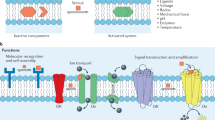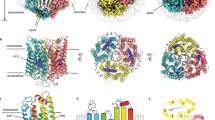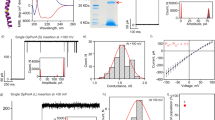Abstract
This protocol details the chemical modification of the mechanosensitive channel of large-conductance (MscL) channel protein into a light-activated nanovalve and its utilization for triggered delivery in synthetic liposomal vesicles. It is based on charge-induced activation of this otherwise mechanosensitive channel by covalent attachment to the protein of rationally designed synthetic functionalities. In the dark, these functionalities will be uncharged and the channel will stay closed, but UV illumination will cause their ionization and trigger channel activity. In the case of reversible activation, subsequent illumination with visible light will neutralize the charge, causing the channel to close. The protocol includes synthesis of light-responsive compounds, protein isolation and its chemical labeling, reconstitution of the protein into artificial membranes, its analysis at the single-molecule level and its application in liposomal delivery. The whole protocol takes 4 days. Unlike mutagenesis, this method allows the introduction of custom-designed functional groups.
This is a preview of subscription content, access via your institution
Access options
Subscribe to this journal
Receive 12 print issues and online access
$259.00 per year
only $21.58 per issue
Buy this article
- Purchase on Springer Link
- Instant access to full article PDF
Prices may be subject to local taxes which are calculated during checkout




Similar content being viewed by others
References
Pellois, J.P. & Muir, T.W. Semisynthetic proteins in mechanistic studies: using chemistry to go where nature can't. Curr. Opin. Chem. Biol. 10, 487–491 (2006).
Astier, Y., Bayley, H. & Howorka, S. Protein components for nanodevices. Curr. Opin. Chem. Biol. 9, 576–584 (2005).
Bayley, H. & Jayasinghe, L. Functional engineered channels and pores. Mol. Membr. Biol. 21, 209–220 (2004).
Banghart, M.R., Volgraf, M. & Trauner, D. Engineering light-gated ion channels. Biochemistry 45, 15129–15141 (2006).
Volgraf, M. et al. Reversibly caged glutamate: a photochromic agonist of ionotropic glutamate receptors. J. Am. Chem. Soc. 129, 260–261 (2007).
Chambers, J.J., Banghart, M.R., Trauner, D. & Kramer, R.H. Light-induced depolarization of neurons using a modified Shaker K(+) channel and a molecular photoswitch. J. Neurophysiol. 96, 2792–2796 (2006).
Volgraf, M. et al. Allosteric control of an ionotropic glutamate receptor with an optical switch. Nat. Chem. Biol. 2, 47–52 (2006).
Kramer, R.H., Chambers, J.J. & Trauner, D. Photochemical tools for remote control of ion channels in excitable cells. Nat. Chem. Biol. 1, 360–365 (2005).
Levina, N. et al. Protection of Escherichia coli cells against extreme turgor by activation of MscS and MscL mechanosensitive channels: identification of genes required for MscS activity. EMBO J. 18, 1730–1737 (1999).
Ajouz, B., Berrier, C., Garrigues, A., Besnard, M. & Ghazi, A. Release of thioredoxin via the mechanosensitive channel MscL during osmotic downshock of Escherichia coli cells. J. Biol. Chem. 273, 26670–26674 (1998).
Berrier, C., Garrigues, A., Richarme, G. & Ghazi A. Elongation factor Tu and DnaK are transferred from the cytoplasm to the periplasm of Escherichia coli during osmotic downshock presumably via the mechanosensitive channel MscL. J. Bacteriol. 182, 248 (2000).
Yoshimura, K., Batiza, A., Schroeder, M., Blount, P. & Kung, C. Hydrophilicity of a single residue within MscL correlates with increased channel mechanosensitivity. Biophys. J. 77, 1960–1972 (1999).
Yoshimura, K., Batiza, A. & Kung, C. Chemically charging the pore constriction opens the mechanosensitive channel MscL. Biophys. J. 80, 2198–2206 (2001).
New, R.R.C. Liposomes: A Practical Approach, 105–161 (IRL Press, Oxford, 1990).
Koçer, A., Walko, M., Meijberg, W. & Feringa, B.L. A light-actuated nanovalve derived from a channel protein. Science 309, 755–759 (2005).
Koçer, A., Walko, M., Bulten, E., Halza, E., Feringa, B.L. & Meijberg, W. Rationally designed chemical modulators convert a bacterial channel protein into a pH-sensory valve. Angew. Chem. Int. Ed. 45, 3126–3130 (2006).
Inoue, M. et al. Alkali-metal cation recognition induced isomerization of spirobenzopyrans and spironapthoxazins possessing a crown ring as a recognition site—multifunctional artificial receptors. J. Org. Chem. 57, 5377–5383 (1992).
Paternostre, M.T., Roux, M. & Rigaud, J.L. Mechanisms of membrane protein insertion into liposomes during reconstitution procedures involving the use of detergents. 1. Solubilization of large unilamellar liposomes (prepared by reverse-phase evaporation) by Triton X-100, octyl glucoside, and sodium cholate. Biochemistry 27, 2668–2677 (1988).
Acknowledgements
We thank the MscL team in Groningen for their support, Dr. G.T. Robillard for critical reading of the manuscript, the neurobiophysics group in University of Groningen for making available the patch-clamp facilities, C.M. Jeronimus-Stratingh and Annie van Dam for the ESI-MS analyses, the Netherlands Organization for Scientific Research (NWO-CW) (B.L.F.), the Materials Science Centre (MSC plus), University of Groningen (M.W. and B.L.F) and Nanoned, a national nanotechnology program coordinated by the Dutch Ministry of Economic Affairs (B.L.F. and A.K.) for financial support.
Author information
Authors and Affiliations
Corresponding authors
Ethics declarations
Competing interests
The authors declare no competing financial interests.
Rights and permissions
About this article
Cite this article
Koçer, A., Walko, M. & Feringa, B. Synthesis and utilization of reversible and irreversible light-activated nanovalves derived from the channel protein MscL. Nat Protoc 2, 1426–1437 (2007). https://doi.org/10.1038/nprot.2007.196
Published:
Issue Date:
DOI: https://doi.org/10.1038/nprot.2007.196
This article is cited by
-
Constructing vesicle-based artificial cells with embedded living cells as organelle-like modules
Scientific Reports (2018)
-
The voltage-dependence of MscL has dipolar and dielectric contributions and is governed by local intramembrane electric field
Scientific Reports (2018)
-
Study of light-induced MscL gating by EPR spectroscopy
European Biophysics Journal (2015)
-
Inducible release of particulates from liposomes using the mechanosensitive channel of large conductance and l-α-lysophosphatidylcholine
European Biophysics Journal (2015)
-
Functional similarities between heterogeneously and homogenously expressed MscL constructs
European Biophysics Journal (2015)
Comments
By submitting a comment you agree to abide by our Terms and Community Guidelines. If you find something abusive or that does not comply with our terms or guidelines please flag it as inappropriate.



